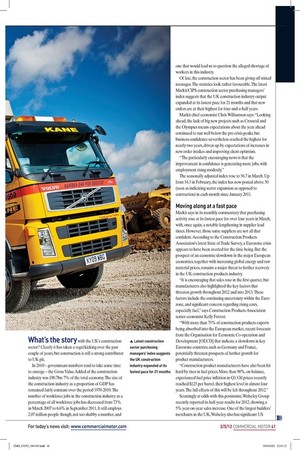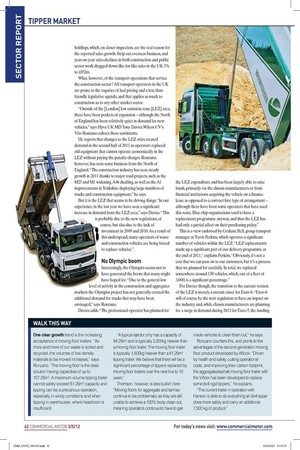Still under
Page 31

Page 32

Page 33

Page 34

If you've noticed an error in this article please click here to report it so we can fix it.
The construction sector in the UK isn’t quite over the recession just yet, but at least it’s moving swiftly along the road Words: Oliver Dixon to recovery What’s the story with the UK’s construction sector? Clearly it has taken a regal kicking over the past couple of years, but construction is still a strong contributor to UK plc.
In 2010 – government numbers tend to take some time to emerge – the Gross Value Added of the construction industry was £90.7bn: 7% of the total economy. The size of the construction industry as a proportion of GDP has remained fairly constant over the period 1970-2010. The number of workforce jobs in the construction industry as a percentage of all workforce jobs has decreased from 7.3% in March 2007 to 6.6% in September 2011. It still employs 2.07 million people though, not too shabby a number, and one that would lead us to question the alleged shortage of workers in this industry.
Of late, the construction sector has been giving off mixed messages. The statistics look rather favourable. The latest Markit/CIPS construction sector purchasing managers’ index suggests that the UK construction industry output expanded at its fastest pace for 21 months and that new orders are at their highest for four-and-a-half years.
Markit chief economist Chris Williamson says: “Looking ahead, the lack of big new projects such as Crossrail and the Olympics means expectations about the year ahead continued to run well below the pre-crisis peaks, but business confidence nevertheless reached the highest for nearly two years, driven up by expectations of increases in new order intakes and improving client optimism.
“The particularly encouraging news is that the improvement in confidence is generating more jobs, with employment rising modestly.” The seasonally adjusted index rose to 56.7 in March. Up from 54.3 in February, the index has now posted above 50 (seen as indicating sector expansion as opposed to contraction) in each month since January 2011.
Moving along at a fast pace
Markit says in its monthly commentary that purchasing activity rose at its fastest pace for over four years in March, with, once again, a notable lengthening in supplier lead times. However, those same suppliers are not all that confident. According to the Construction Products Association’s latest State of Trade Survey, a Eurozone crisis appears to have been averted for the time being. But the prospect of an economic slowdown in the major European economies, together with increasing global energy and raw material prices, remains a major threat to further recovery in the UK construction products industry.
“It is encouraging that sales rose in the first quarter, but manufacturers also highlighted the key factors that threaten growth throughout 2012 and into 2013. These factors include the continuing uncertainty within the Euro zone, and significant concern regarding rising costs, especially fuel,” says Construction Products Association senior economist Kelly Forrest.
“With more than 75% of construction products exports being absorbed into the European market, recent forecasts from the Organisation for Economic Co-operation and Development [OECD] that indicate a slowdown in key Eurozone countries, such as Germany and France, potentially threaten prospects of further growth for product manufacturers.
“Construction product manufacturers have also been hit hard by rises in fuel prices. More than 90%, on balance, experienced fuel price inflation in Q1. Oil prices recently reached $125 per barrel, their highest level in almost four years. The full effects of this will be felt throughout 2012.” Seemingly at odds with this pessimism, Wolseley Group recently reported its half-year results for 2012, showing a 5% year-on-year sales increase. One of the largest builders’ merchants in the UK, Wolseley also has significant US holdings, which, on closer inspection, are the real reason for the reported sales growth. Strip out overseas business, and year-on-year sales declines in both construction and public sector work dragged down like-for-like sales in the UK 3% to £852m.
What, however, of the transport operations that service the construction sector? All transport operators in the UK are prone to the vagaries of fuel pricing and a less-thanfriendly legislative agenda, and that applies as much to construction as to any other market sector.
“Outside of the [London] low emission zone [LEZ] area, there have been pockets of expansion – although the North of England has been relatively quiet in demand for new vehicles,” says Hyva UK MD Tony Davies.Wilcox CV’s Vito Ronzano echoes these sentiments.
He reports that changes to the LEZ rules created demand in the second half of 2011 as operators replaced old equipment that cannot operate economically in the LEZ without paying the penalty charges. Ronzano, however, has seen some business from the North of England. “The construction industry has seen steady growth in 2011 thanks to major road projects, such as the M25 and M1 widening, A46 dualling, as well as the A1 improvements in Yorkshire deploying large numbers of trucks and construction equipment,” he says.
But it is the LEZ that seems to be driving things. “In our experience, in the last year we have seen a significant increase in demand from the LEZ area,” says Davies. “This is probably due to the new regulations, of course, but also due to the lack of investment in 2009 and 2010. As a result of this underspend, many operators of waste and construction vehicles are being forced to replace vehicles.”
No Olympic boom
Interestingly, the Olympics seems not to have generated the boom that many might have hoped for. “Due to the general low level of activity in the construction and aggregates markets the Olympics project has not generally created the additional demand for trucks that may have been envisaged,” says Ronzano.
Davies adds: “The professional operator has planned for the LEZ expenditure and has been largely able to raise funds, primarily via the chassis manufacturers or from financial institutions acquiring the vehicle on a finance lease as opposed to a contract hire type of arrangement – although there have been some operators that have used this route. Blue chip organisations tend to have a replacement programme anyway, and thus the LEZ has had only a partial affect on their purchasing policy.” This is a view endorsed by Graham Bell, group transport manager at Travis Perkins, which operates a significant number of vehicles within the LEZ. “LEZ replacements made up a significant part of our delivery programme at the end of 2011,” explains Perkins. “Obviously, it’s not a cost that we can pass on to our customers, but it’s a process that we planned for carefully. In total, we replaced somewhere around 130 vehicles, which, out of a fleet of 3,000, is a significant percentage.” For Davies though, the transition to the current version of the LEZ is merely a curtain raiser for Euro-6. “Euro-6 will of course be the next regulation to have an impact on the industry and, while chassis manufacturers are planning for a surge in demand during 2013 for Euro-5, the funding still has to be available. Operators have the same issues as other businesses in obtaining suitable financing,” he says.
While Euro-6 is an issue to be mindful of, David Thomson, MD at Weightlifter Group, believes the introduction of Whole Vehicle Type Approval (WVTA) will have a major impact on the tipper bodybuilding industry as well as having knock-on effects for operators. Many smaller bodybuilders could well find that the cost of gaining single vehicle type approval will be prohibitive, forcing them to cease operations. For those that remain in business, delays in approval will inevitably mean longer completion times and consequently late delivery to customers. It is likely that Vosa test stations will be charged with carrying out the testing and this too will lead to operators experiencing even more delays as they book for annual tests.
Good news?
“Manufacturers in the tipper and bulk sector have experienced many challenges over the last few years as the market has been particularly volatile,” says Thomson. Rigid tippers continue to have a place in the UK and eight-wheeler sales have recently seen a modest up-turn, albeit from a historic low. Six-wheeler sales, however, have reached an all-time low, despite having some VED advantages. Meanwhile sales of tipping semi-trailers remain consistent, with a standard requirement for 50m3 capacity. But a fiercely competitive market means prices remain low. This is good news for operators as it means they can achieve excellent value for money, but bad news for trailer makers. It is likely that there will be more casualties in the tipper trailer industry as a direct result of a cut-throat marketplace, where some seem to be selling below the cost of manufacture.
“Wilcox has seen an increase in its trailer sales through the recession,” says Ronzano. “Traditionally the mix was 60% rigids and 40% trailers. However, through the recession this has been turned on its head with a low in 2010, of just being 30% rigid bodies and 70% trailers. In 2011 the split moved to 39% of units manufactured being rigids.” Thomson adds: “We believe that the whole life cost of running a vehicle is the most important factor for operators. To help them keep this as low as possible, the company ensures its products are built to last and can point to many examples of 20and even 30-year-old Weightlifter-bodied trucks and trailers still giving sterling service. Excellent parts and service back-up is essential, and Weightlifter now has three dedicated service depots which offer ‘drive-in’ repair facilities to get the vehicle back on the road as quickly as possible.” The age of the fleet has not passed Wilcox by either. “As you drive around the country you will see that, among the small number of new rigids and trailers, there are many old, past-their-sell-by-date trucks and trailers,” says Ronzano.
“There are a growing number of operators who know they should replace the equipment, but are waiting to see what is around the corner for them.
“Some operators just plan to work for another year or two until they can hang up the keys and retire.
“In particular chassis cabs have increased in price by as much as 15%, we are told, and the trucks that they would normally change at three years old are now five or six years old. Those older trucks do not have the residual value and therefore the cost to change is twice of what they are used to,” continues Ronzano.
“Finance is far harder to arrange in today’s low profit and uncertain market place than it was pre-recession. On a positive note, the quarry operators and larger hauliers are investing in new equipment in order to reduce their costs, carbon footprint and secure their futures.” But despite the doom and gloom, the tipping and bulk transport industry continues to prove its resilience, says Thomson. “New products are continually being developed and new production techniques and quality control systems mean products are better built and more reliable than ever before. Meanwhile operators are making better, more profitable use of their vehicles by specifying them with greater flexibility in mind.” n l Tip-Ex 2012 takes place in Harrogate from 25-27 May










































